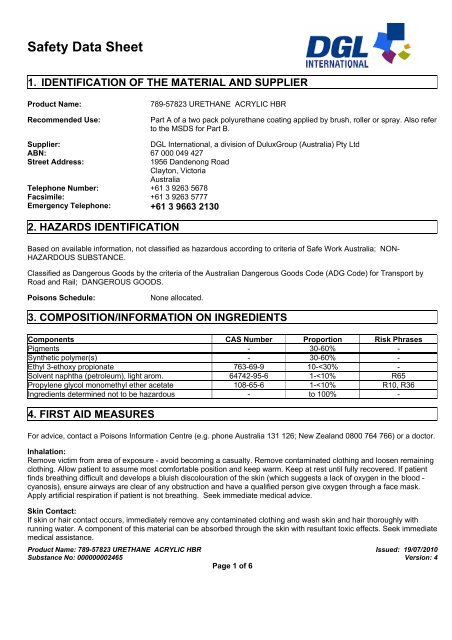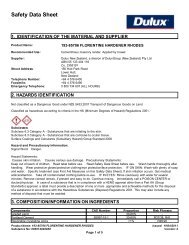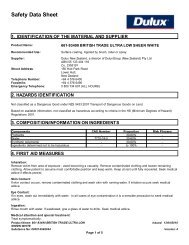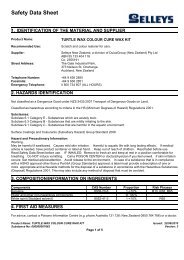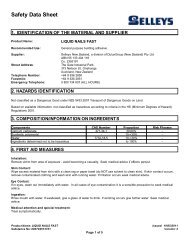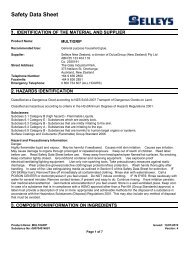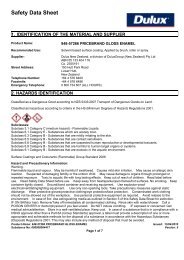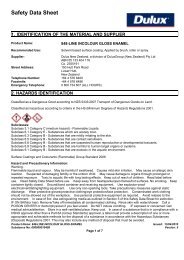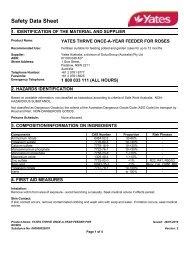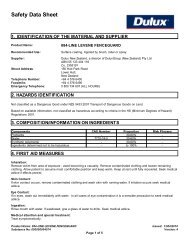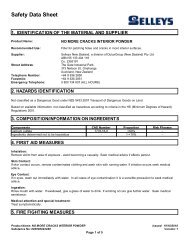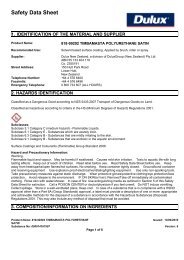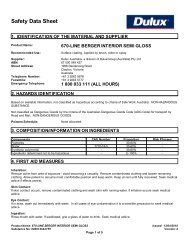urethane acrylic hbr - Safety Data Sheets
urethane acrylic hbr - Safety Data Sheets
urethane acrylic hbr - Safety Data Sheets
Create successful ePaper yourself
Turn your PDF publications into a flip-book with our unique Google optimized e-Paper software.
<strong>Safety</strong> <strong>Data</strong> Sheet<br />
1. IDENTIFICATION OF THE MATERIAL AND SUPPLIER<br />
Product Name: 789-57823 URETHANE ACRYLIC HBR<br />
Recommended Use: Part A of a two pack poly<strong>urethane</strong> coating applied by brush, roller or spray. Also refer<br />
to the MSDS for Part B.<br />
Supplier: DGL International, a division of DuluxGroup (Australia) Pty Ltd<br />
ABN: 67 000 049 427<br />
Street Address: 1956 Dandenong Road<br />
Clayton, Victoria<br />
Australia<br />
Telephone Number: +61 3 9263 5678<br />
Facsimile: +61 3 9263 5777<br />
Emergency Telephone: +61 3 9663 2130<br />
2. HAZARDS IDENTIFICATION<br />
Based on available information, not classified as hazardous according to criteria of Safe Work Australia; NON-<br />
HAZARDOUS SUBSTANCE.<br />
Classified as Dangerous Goods by the criteria of the Australian Dangerous Goods Code (ADG Code) for Transport by<br />
Road and Rail; DANGEROUS GOODS.<br />
Poisons Schedule: None allocated.<br />
3. COMPOSITION/INFORMATION ON INGREDIENTS<br />
Components CAS Number Proportion Risk Phrases<br />
Pigments - 30-60% -<br />
Synthetic polymer(s) - 30-60% -<br />
Ethyl 3-ethoxy propionate 763-69-9 10-
<strong>Safety</strong> <strong>Data</strong> Sheet<br />
Eye Contact:<br />
If in eyes, wash out immediately with water. In all cases of eye contamination it is a sensible precaution to seek medical<br />
advice.<br />
Ingestion:<br />
Rinse mouth with water. If swallowed, do NOT induce vomiting. Give a glass of water. Seek immediate medical<br />
assistance.<br />
Medical attention and special treatment:<br />
Treat symptomatically.<br />
5. FIRE FIGHTING MEASURES<br />
Hazards from combustion products:<br />
Flammable liquid. On burning will emit toxic fumes, including those of oxides of carbon .<br />
Precautions for fire fighters and special protective equipment:<br />
Keep containers cool with water spray. If safe to do so, remove containers from path of fire. Fire fighters to wear selfcontained<br />
breathing apparatus and suitable protective clothing if risk of exposure to vapour or products of combustion.<br />
Suitable Extinguishing Media:<br />
Alcohol resistant foam is the preferred firefighting medium but, if it is not available, normal protein foam can be used.<br />
Hazchem Code: · 3Y<br />
6. ACCIDENTAL RELEASE MEASURES<br />
Emergency procedures:<br />
If contamination of sewers or waterways has occurred advise local emergency services.<br />
Methods and materials for containment and clean up:<br />
Shut off all possible sources of ignition. Clear area of all unprotected personnel. Slippery when spilt. Avoid accidents,<br />
clean up immediately. Wear protective equipment to prevent skin and eye contact and breathing in vapours. Work up<br />
wind or increase ventilation. Contain - prevent run off into drains and waterways. Use absorbent (soil, sand or other inert<br />
material). Collect and seal in properly labelled containers or drums for disposal.<br />
7. HANDLING AND STORAGE<br />
Conditions for safe storage:<br />
Store away from sources of heat or ignition. Store away from foodstuffs. Store away from incompatible materials<br />
described in Section 10. Keep containers closed when not in use - check regularly for leaks.<br />
Precautions for safe handling:<br />
Avoid skin and eye contact and breathing in vapour, mists and aerosols. May form flammable vapour mixtures with air.<br />
All potential sources of ignition (open flames, pilot lights, furnaces, spark producing switches and electrical equipment etc)<br />
must be eliminated both in and near the work area. Do NOT smoke. Flameproof equipment is necessary in all areas<br />
where this chemical is being used. Nearby equipment must be earthed. Vapour may travel a considerable distance to<br />
source of ignition and flash back.<br />
8. EXPOSURE CONTROLS/PERSONAL PROTECTION<br />
Product Name: 789-57823 URETHANE ACRYLIC HBR Issued: 19/07/2010<br />
Substance No: 000000002465 Version: 4<br />
Page 2 of 6
<strong>Safety</strong> <strong>Data</strong> Sheet<br />
Occupational Exposure Limits: No value assigned for this specific material by the National Occupational Health and<br />
<strong>Safety</strong> Commission. However, Exposure Standard(s) for constituent(s):<br />
1-Methoxy-2-propanol acetate: 8hr TWA = 274 mg/m 3 (50 ppm), 15 min STEL = 548 mg/m 3 (100 ppm), Sk<br />
As published by the National Occupational Health and <strong>Safety</strong> Commission.<br />
TWA - The time-weighted average airborne concentration over an eight-hour working day, for a five-day working week<br />
over an entire working life.<br />
STEL (Short Term Exposure Limit) - the average airborne concentration over a 15 minute period which should not be<br />
exceeded at any time during a normal eight hour work day. According to current knowledge this concentration should<br />
neither impair the health of, nor cause undue discomfort to, nearly all workers.<br />
`Sk' Notice - absorption through the skin may be a significant source of exposure. The exposure standard is invalidated if<br />
such contact should occur.<br />
These Exposure Standards are guides to be used in the control of occupational health hazards. All atmospheric<br />
contamination should be kept to as low a level as is workable. These exposure standards should not be used as fine<br />
dividing lines between safe and dangerous concentrations of chemicals. They are not a measure of relative toxicity.<br />
Engineering controls:<br />
Ensure ventilation is adequate and that air concentrations of components are controlled below quoted Exposure<br />
Standards. Vapour heavier than air - prevent concentration in hollows or sumps. DO NOT enter confined spaces where<br />
vapour may have collected. Keep containers closed when not in use.<br />
Personal Protective Equipment:<br />
The selection of PPE is dependant on a detailed risk assessment. The risk assessment should consider the work<br />
situation, the physical form of the chemical, the handling methods, and environmental factors.<br />
Personal Protection: I - OVERALLS, SAFETY SHOES, FACE SHIELD OR AIR MASK, GLOVES (Long).<br />
Wear overalls, impervious gloves and a positive pressure air supplied full-face respirator. Apply in a spray booth fitted<br />
with an effective exhaust system and comply with local regulations applicable to spray painting. The spray booth should<br />
be isolated from other people whilst spraying is in progress and until all spray mist has been effectively dispersed.<br />
Catalysed product deteriorates on contact with moisture liberating gas. The can may be under pressure. Before opening,<br />
place cloth over lid to prevent contents splashing. To open, hold hand firmly on cloth over lid to prevent lid flying off, then<br />
lever lid off gradually. Avoid breathing dust when sanding. Wet sand or use a dust mask. Always wash hands before<br />
smoking, eating, drinking or using the toilet.<br />
9. PHYSICAL AND CHEMICAL PROPERTIES<br />
Physical state: Viscous liquid<br />
Colour: Coloured<br />
Product Name: 789-57823 URETHANE ACRYLIC HBR Issued: 19/07/2010<br />
Substance No: 000000002465 Version: 4<br />
Page 3 of 6
<strong>Safety</strong> <strong>Data</strong> Sheet<br />
Odour: Solvent<br />
Solubility: Soluble in organic solvents. Insoluble in water.<br />
Specific Gravity: 1-1.5 @20°C<br />
Relative Vapour Density (air=1): >1<br />
Vapour Pressure (20 °C): Not available<br />
Flash Point (°C): 42<br />
Flammability Limits (%): Not available<br />
Autoignition Temperature (°C): Not available<br />
% Volatile by Volume: Not available<br />
Solubility in water (g/L): Negligible<br />
Melting Point/Range (°C): Not applicable<br />
Boiling Point/Range (°C): Not available<br />
Decomposition Point (°C): Not available<br />
pH: Not applicable<br />
Viscosity: Not available<br />
Evaporation Rate: Not available<br />
10. STABILITY AND REACTIVITY<br />
Chemical stability: Stable under normal conditions of use.<br />
Conditions to avoid: Avoid contact with foodstuffs. Avoid exposure to heat, sources of ignition, and open<br />
flame.<br />
Incompatible materials: Incompatible with oxidising agents.<br />
Hazardous decomposition<br />
products:<br />
Oxides of carbon.<br />
Hazardous reactions: Hazardous polymerisation will not occur.<br />
11. TOXICOLOGICAL INFORMATION<br />
No adverse health effects expected if the product is handled in accordance with this <strong>Safety</strong> <strong>Data</strong> Sheet and the product<br />
label. Symptoms or effects that may arise if the product is mishandled and overexposure occurs are:<br />
Ingestion: Swallowing can result in nausea, vomiting and central nervous system depression. If<br />
the victim is showing signs of central system depression (like those of drunkeness)<br />
there is greater likelihood of the patient breathing in vomit and causing damage to<br />
the lungs. Breathing in vomit may lead to aspiration pneumonia (inflammation of the<br />
lung).<br />
Eye contact: May be an eye irritant.<br />
Skin contact: Contact with skin will result in irritation. Will have a degreasing action on the skin.<br />
Repeated or prolonged skin contact may lead to irritant contact dermatitis.<br />
Component/s of this material can be absorbed through the skin with resultant toxic<br />
effects.<br />
Product Name: 789-57823 URETHANE ACRYLIC HBR Issued: 19/07/2010<br />
Substance No: 000000002465 Version: 4<br />
Page 4 of 6
<strong>Safety</strong> <strong>Data</strong> Sheet<br />
Inhalation: Material may be irritant to the mucous membranes of the respiratory tract (airways).<br />
Breathing in vapour can result in headaches, dizziness, drowsiness, and possible<br />
nausea. Breathing in high concentrations can produce central nervous system<br />
depression, which can lead to loss of co-ordination, impaired judgement and if<br />
exposure is prolonged, unconsciousness.<br />
Long Term Effects:<br />
No information available for the product. For the intermixed paint (mix of Parts A&B): May cause skin sensitisation.<br />
Inhalation of aerosol droplets may cause respiratory sensitisation in some susceptible workers with asthma-like<br />
symptoms. Repeated exposure may lead to permanent respiratory disability (2).<br />
Toxicological <strong>Data</strong>: No LD50 data available for the product. For the constituent Ethyl 3-ethoxy propionate (1):<br />
Oral LD50 (rat): 5000 mg/kg<br />
Dermal LD50 (rabbit): 4076 mg/kg<br />
Inhalation LC50 (rat): 1250 ppm/4 Hrs<br />
12. ECOLOGICAL INFORMATION<br />
Ecotoxicity Avoid contaminating waterways.<br />
13. DISPOSAL CONSIDERATIONS<br />
Disposal methods:<br />
Refer to Waste Management Authority. Dispose of material through a licensed waste contractor. Advise flammable<br />
nature. Normally suitable for incineration by an approved agent.<br />
14. TRANSPORT INFORMATION<br />
Road and Rail Transport<br />
Classified as Dangerous Goods by the criteria of the Australian Dangerous Goods Code (ADG Code) for Transport by<br />
Road and Rail; DANGEROUS GOODS.<br />
FLAMMABLE<br />
LIQUID<br />
3<br />
UN No: 1263<br />
Class-primary 3 Flammable Liquid<br />
Packing Group: III<br />
Proper Shipping Name: PAINT<br />
Hazchem Code: · 3Y<br />
Marine Transport<br />
Classified as Dangerous Goods by the criteria of the International Maritime Dangerous Goods Code (IMDG Code) for<br />
transport by sea; DANGEROUS GOODS.<br />
UN No: 1263<br />
Class-primary: 3 Flammable Liquid<br />
Packing Group: III<br />
Proper Shipping Name: PAINT<br />
Product Name: 789-57823 URETHANE ACRYLIC HBR Issued: 19/07/2010<br />
Substance No: 000000002465 Version: 4<br />
Page 5 of 6
<strong>Safety</strong> <strong>Data</strong> Sheet<br />
Air Transport<br />
Classified as Dangerous Goods by the criteria of the International Air Transport Association (IATA) Dangerous Goods<br />
Regulations for transport by air; DANGEROUS GOODS.<br />
UN No: 1263<br />
Class-primary: 3 Flammable Liquid<br />
Packing Group: III<br />
Proper Shipping Name: PAINT<br />
15. REGULATORY INFORMATION<br />
Classification: Based on available information, not classified as hazardous according to criteria of<br />
Safe Work Australia; NON-HAZARDOUS SUBSTANCE.<br />
Poisons Schedule: None allocated.<br />
All the constituents of this material are listed on the Australian Inventory of Chemical Substances (AICS).<br />
16. OTHER INFORMATION<br />
Literary reference (1) Supplier Material <strong>Safety</strong> <strong>Data</strong> Sheet; 12/ 2006.<br />
(2) In 'Exposure Standards for Atmospheric Contaminants in the Occupational<br />
Environment 3rd Edition (Ed. NOHSC), Australian Government Publishing Service<br />
Canberra (1995).<br />
Reason(s) for Issue:<br />
Revised Primary SDS<br />
Alignment to HSNO requirements<br />
This safety data sheet has been prepared by SH&E Shared Services.<br />
This SDS summarises to our best knowledge at the date of issue, the chemical health and safety hazards of the material<br />
and general guidance on how to safely handle the material in the workplace. Since DuluxGroup Limited cannot anticipate<br />
or control the conditions under which the product may be used, each user must, prior to usage, assess and control the<br />
risks arising from its use of the material.<br />
If clarification or further information is needed, the user should contact their DuluxGroup representative or DuluxGroup<br />
Limited at the contact details on page 1.<br />
DuluxGroup Limited's responsibility for the material as sold is subject to the terms and conditions of sale, a copy of which<br />
is available upon request.<br />
Product Name: 789-57823 URETHANE ACRYLIC HBR Issued: 19/07/2010<br />
Substance No: 000000002465 Version: 4<br />
Page 6 of 6


